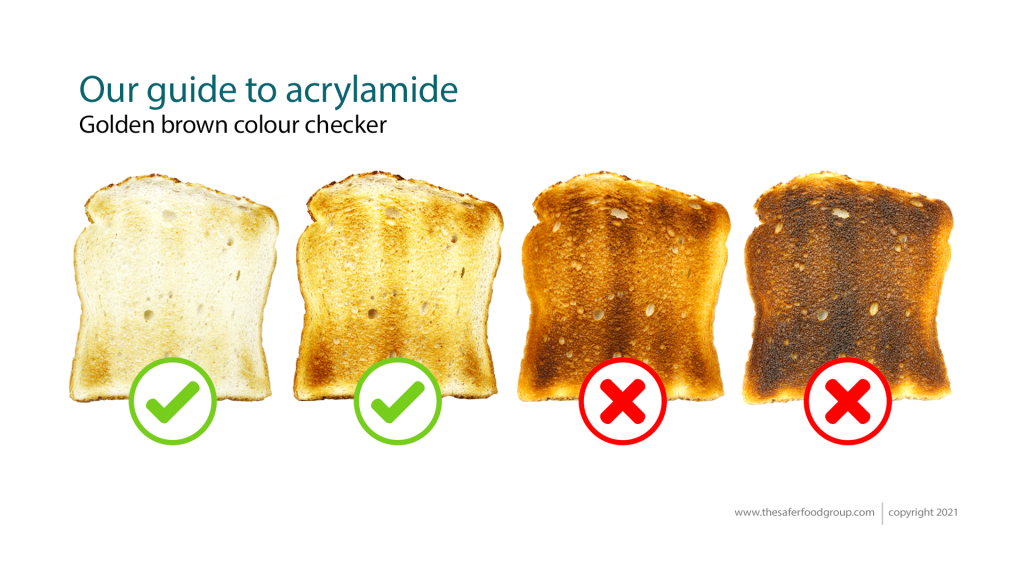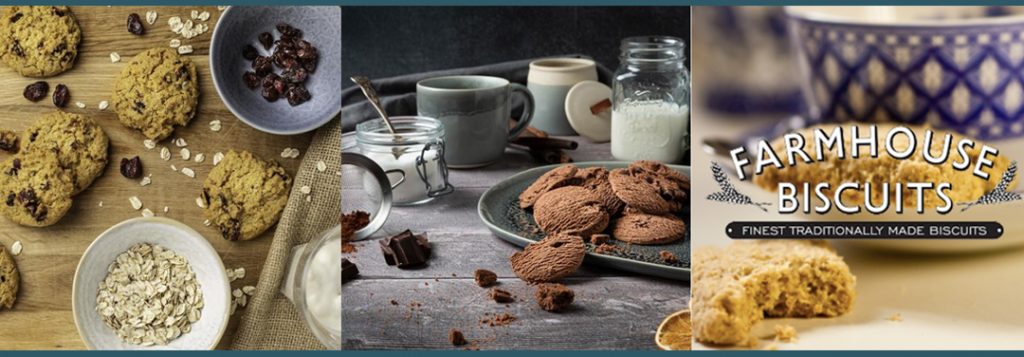Acrylamide is a chemical that forms during a reaction between sugars and amino acids in starchy food, particularly when that food is cooked at high temperatures. Based on scientific studies, it is believed to be carcinogenic – that means, cancer forming – and therefore we should all be aware of its presence and understand what we can do to minimise its production when we cook.
Food handlers and food businesses have a legal responsibility to ensure that the food they produce is safe to eat. Therefore, all food businesses should be aware of and take steps to minimise the production of acrylamide when purchasing, storing, preparing and cooking food, and food handlers should follow any plans that are put in place. The responsibility of food handlers and producers to minimise acrylamide levels is specifically addressed in EU Regulation 2017/2158.

The most obvious indicator that a food has been cooked at too high a temperature is its colour – make sure fried, toasted or baked products reach a golden yellow, or lighter colour. Other quick tips include:
However, there are many more steps within the purchasing, storage, preparation and cooking processes that you need to follow to stay safe – we recommend you refer to Safer Food, Better Business or your relevant industry guides for more detailed information.
The ICO, or Information Commissioner’s Office, oversees the safe handling of personal data within companies. Under the Data Protection Act 1998, any organisation that processes personal information must register with the ICO. While failure to do so is a criminal offence, some organisations may be exempt and may not need to register or ‘notify’ the Information Commissioner’s Office.
Personal data is information about individual people, where they live, what they do and more. It’s any and all information that identifies them, including:
If a document, file or image identifies a person, or could be used in combination with other information to identify them, then it’s personal data. This applies even if the information doesn’t include a person’s name.
Handling personal data means taking any action with someone’s personal data. This begins when a business starts making a record of information about someone, and continues until they no longer need the information and it’s been securely destroyed. If you hold information on someone, it counts as processing even if you don’t do anything else with it.
So, in the example of a fish and chip shop, personal data might include a list of customers’ names, addresses and phone numbers that they use for ordering and delivering food, or images that they record on their CCTV system.
Organisations that only processes personal information for:
Some not-for-profit organisations;
Organisations that process personal data only for maintaining a public register;
Organisations that do not process personal information on computer.
You might use personal data in a slightly different way to the examples described above. To check whether your business needs to register with the ICO, follow this link to their self assessment tool and answer the questions…
Red for meat, white for bread, green for vegetables.... or is it yellow? Or is that for cooked meat? Coloured chopping boards can be a great way of reducing cross contamination but they depend on everyone remembering the system and sticking to it.
The principle behind coloured chopping boards is that foods that run the risk of carrying pathogenic bacteria are kept away from those that don't. Raw meats and fish are high risk food. They may carry low levels of bacteria even before they enter your kitchen, so it is important that any surface and utensils you use for these foods are cleaned and disinfected BEFORE they are used for other foods. This is where a coloured chopping board can be useful - but only if everyone knows that red boards are for raw meats and blue for raw fish - and thorough cleaning and disinfection is still vital in between uses.
Cooked meats, cheeses and ready to eat chilled foods are also high risk foods, as they are high in protein and moisture and are an ideal breeding ground for bacteria in the wrong conditions. Traditionally, cooked meats would be chopped on yellow boards, and cheese on a white board, alongside bakery - but here is another flaw in the process; if not kept safely, cheese may contain bacteria such as Listeria monocytogenes, Staphylococcus aureus, Escherichia coli, or Salmonella enterica, therefore using an unwashed chopping board for both bread and cheese runs a risk of cross contamination.
A relatively new addition to the world of coloured chopping boards is the purple board, for allergens. Again, this is a really tricky area. Using a separate board for allergenic ingredients can help ensure that they don't find their way into 'allergen free' dishes - but it doesn't guarantee that traces of one allergen doesn't contaminate dishes containing a different stated allergen. And don't forget that some allergens can become airborne - a purple chopping board is not an effective safeguard against peanut dust circulating throughout your kitchen.
In summary, coloured chopping boards can be an extra safeguard against cross contamination, as long as your system is understood and followed by every member of your kitchen team. But be careful they don't lead to complacent working practices or a replacement for thorough washing and disinfection between uses.
Need more information about introducing safe practices into your kitchen? Have a look at our Level 2 Food Hygiene, Level 2 HACCP and Level 3 Food Safety (Supervisors) courses today.
Diversification from agriculture into food production and retail feels like a very modern way for farming businesses to adapt and thrive. However, the McIvor family of Higher Oaklands Farm spotted this opportunity in the 1960s, when Farmhouse Biscuits was born.
Growing successfully from tiny roots, Farmhouse Biscuits still operates using the same family values and traditional methods – and the manufacturing business has also embedded a culture of food safety, and a dedication to the wellbeing of its 300-strong team. The staff tell us it’s a great place to work, and their hard work is reflected in a Grade A+ Certification to the BRC Global Standard for Food Safety, for continuous improvement in food safety, hygiene and quality procedure.
Carel van Bentum, Facilities Manager of the Lancashire based production facility explained how Safer Food Group training is woven into the working lives of their team members. Food Safety and Allergen Awareness are tackled as part of a comprehensive induction programme for new staff. Making use of the flexibility of Safer Food Group training, courses are delivered both online and with the help of tutors in a classroom setting.
And Safer Food Group systems benefit the management team too. Carel can keep a track on learners’ progress, as well as spotting certificates due for renewal using the admin system in his business account – vital when you have a big team to support.
It’s always rewarding to play a small part in the success of a brilliant business – and we love supporting Carel and his team almost as much as we love eating their biscuits! Why not visit their shop and make sure you’re stocked up for National Biscuit Day (yes, really!) on 29th May?

In our third post looking at food safety training from the perspective our customers, we talk to Jilly Shah, of Jilly’s Cupcake House, whose charity cake baking turned into a business more than 5 years ago. Jilly started raising money for the A-T Society in 2015, but as orders flooded in, her hobby became her business.
It was at this point, Jilly told us, “I realised I needed to get professional and get Level 2 Hygiene certified. I found the Safer Food Group in a Google search and I’m so glad I did. Studying the course videos gave me so much encouragement and motivation. Not to mention how entertaining Marcus and Nick were throughout the course; it was so enjoyable!
Completing the course helped me so much in my business. I run my bakery from home, so all the tips and guidance I learnt from the course really helped me to transform my home bakery into a professional environment.”
As someone affected by A-T, Jilly continues to run her business with all profits going to the A-T society. We’re glad we have helped just a little in Jilly’s journey, and wish her lots of baking success in the future.

The Safer Food Group
Unit 2, Integrity House,
Lower Lumsdale, Matlock
DE4 5EX
Back
to top
© The Safer Food Group 2024 | Privacy policy